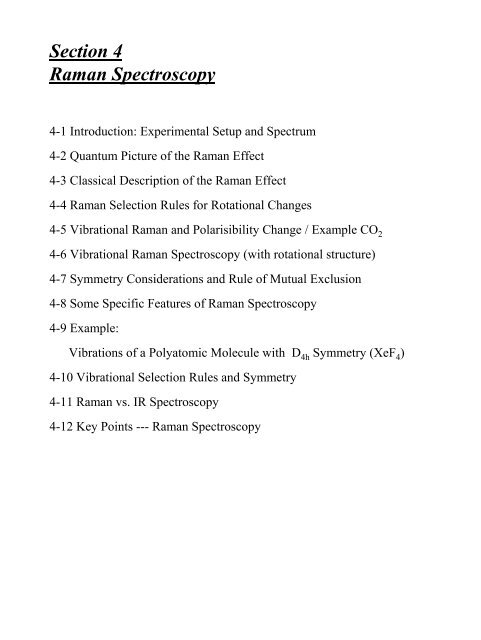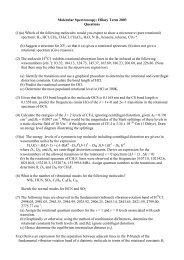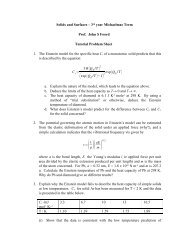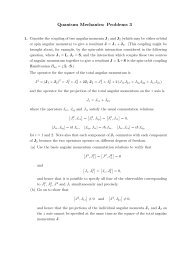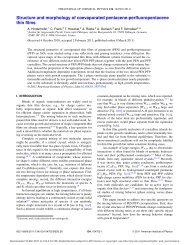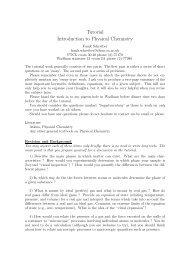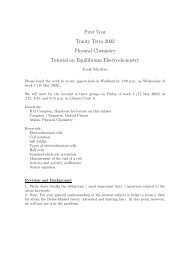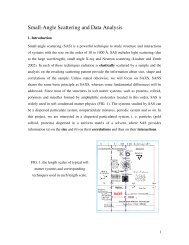Section 4 Raman Spectroscopy
Section 4 Raman Spectroscopy
Section 4 Raman Spectroscopy
Create successful ePaper yourself
Turn your PDF publications into a flip-book with our unique Google optimized e-Paper software.
<strong>Section</strong> 4<br />
<strong>Raman</strong> <strong>Spectroscopy</strong><br />
4-1 Introduction: Experimental Setup and Spectrum<br />
4-2 Quantum Picture of the <strong>Raman</strong> Effect<br />
4-3 Classical Description of the <strong>Raman</strong> Effect<br />
4-4 <strong>Raman</strong> Selection Rules for Rotational Changes<br />
4-5 Vibrational <strong>Raman</strong> and Polarisibility Change / Example CO 2<br />
4-6 Vibrational <strong>Raman</strong> <strong>Spectroscopy</strong> (with rotational structure)<br />
4-7 Symmetry Considerations and Rule of Mutual Exclusion<br />
4-8 Some Specific Features of <strong>Raman</strong> <strong>Spectroscopy</strong><br />
4-9 Example:<br />
Vibrations of a Polyatomic Molecule with D 4h Symmetry (XeF 4 )<br />
4-10 Vibrational Selection Rules and Symmetry<br />
4-11 <strong>Raman</strong> vs. IR <strong>Spectroscopy</strong><br />
4-12 Key Points --- <strong>Raman</strong> <strong>Spectroscopy</strong>
<strong>Raman</strong> <strong>Spectroscopy</strong>
Quantum Picture of the <strong>Raman</strong> Effect
Classical Description of the <strong>Raman</strong> Effect<br />
Vibrations<br />
Rotations
<strong>Raman</strong> Selection Rules for Rotational Changes
Vibrational <strong>Raman</strong> and Polarisability Change
Vibrational <strong>Raman</strong> <strong>Spectroscopy</strong><br />
(with rotational (sub)-structure)
Symmetry Considerations and<br />
Rule of Mutual Exclusion<br />
IR<br />
For a vibration to be IR active, it must<br />
transform in the same way as x, y, or z (translations)<br />
<strong>Raman</strong><br />
For a vibration to be <strong>Raman</strong> active, it must transform in<br />
the same way as x 2 , y 2 , z 2 , xy, xz or yz.<br />
Rule of mutual exclusion<br />
If a molecule has a centre of symmetry then IR active<br />
vibrations are <strong>Raman</strong> inactive and vice versa.<br />
Note that there may be modes inactive in both.<br />
If a molecule has no centre of symmetry then some (but<br />
not necessarily all) vibrations may be both IR<br />
and <strong>Raman</strong> active.
Some Specific Features of <strong>Raman</strong> <strong>Spectroscopy</strong><br />
1) Resonance <strong>Raman</strong><br />
resonant<br />
scattered<br />
radiation<br />
E el<br />
-<br />
… if incident radation nearly conincides with the<br />
energy of an electronic transition of the sample.<br />
-> intensity of the <strong>Raman</strong> scattered radiation is<br />
strongly enhanced.<br />
-> applications for pigments (β-carotene;<br />
chlorophyll; phthalocyanines etc.) with strong<br />
absorption in the UV and visible region of the<br />
spectrum.<br />
-> This leads to a certain degree of selectivity if<br />
these pigments are bound to very large biological<br />
molecules, and only certain vibrational excitations<br />
in specific parts of the molecule are enhanced.<br />
2) Polarisation characteristics<br />
Incident<br />
radiation<br />
II II<br />
Only transitions involving totally symmetric<br />
vibrational modes give rise to polarised <strong>Raman</strong><br />
bands (i.e. for the scattered radiation).<br />
All others are depolarised.<br />
This is a considerable help in the assignment.<br />
(see Haken/Wolf; Atkins; Davidson; Woodward<br />
for details)<br />
II I<br />
Scattered<br />
radiation
Example: Xe F 4
Vibrational Selection Rules and Symmetry
<strong>Raman</strong> vs IR <strong>Spectroscopy</strong><br />
1) Nature of the process:<br />
--- IR absorption: “1-photon process”, <strong>Raman</strong>: “2-photon process”;<br />
(thus <strong>Raman</strong> cross sections usually weak)<br />
--- IR absorption: changes parity, <strong>Raman</strong>: conserves parity<br />
2) Complementarity for vibrational modes<br />
(Rule of mutual exclusion for centrosymmetric molecules)<br />
3) <strong>Raman</strong>: Wavelength of primary radiation can be conveniently chosen<br />
4) Specific polarisation features for <strong>Raman</strong> can help with identification<br />
of nature of modes<br />
5) Resonance <strong>Raman</strong><br />
In complex molecules vibrational excitations in specific parts of the<br />
molecule can be studied by using primary radiation near the excitation<br />
levels of this part (thus some degree of selectivity)<br />
6) <strong>Raman</strong> can be applied with good spatial resolution<br />
(more difficult for IR)<br />
7) <strong>Raman</strong> scattering by water is weak (compared to IR), which is good<br />
for studying samples surrounded by water (an important solvent)<br />
8) <strong>Raman</strong> has an essentially frequency independent penetration depth<br />
into the surrounding medium, IR penetration depth may vary more<br />
strongly (normalisation easier for <strong>Raman</strong>)<br />
9) For samples with significant fluorescence background (excited by the<br />
primary radiation), it may be difficult to distinguish the <strong>Raman</strong> signal<br />
from the background.
Key Points --- <strong>Raman</strong> <strong>Spectroscopy</strong><br />
1) Nature of the <strong>Raman</strong> process<br />
--- incoming radiation hν -> outgoing radiation hν’<br />
--- <strong>Raman</strong>: “2-photon process” (IR absorption: “1-photon process”)<br />
(thus <strong>Raman</strong> cross sections usually weak)<br />
--- <strong>Raman</strong>: “conserves parity” (IR absorption: changes parity)<br />
2) Selection rules<br />
--- rotational transitions<br />
∆ J = +- 2 (or 0)<br />
--- vibrational transitions<br />
∆ v = +- 1<br />
and anisotropic polarisability<br />
and polarisability change upon vibration<br />
3) IR vs <strong>Raman</strong><br />
a) Complementarity for vibrational modes<br />
(Rule of mutual exclusion for centrosymmetric molecules)<br />
b) Experimental considerations (<strong>Raman</strong>):<br />
i) Wavelength of primary radiation can be conveniently chosen<br />
ii) Polarisation features can help with identification of nature of modes<br />
iii) Resonance <strong>Raman</strong>: stronger signal (and potentially selective)<br />
iv) <strong>Raman</strong> can be applied with good spatial resolution<br />
v) <strong>Raman</strong> scattering by water is weak (compared to IR)<br />
vi) <strong>Raman</strong> has an essentially frequency independent penetration depth<br />
vii) For samples with significant fluorescence background (excited by<br />
the primary radiation), it may be difficult to distinguish the <strong>Raman</strong><br />
signal from the background.


